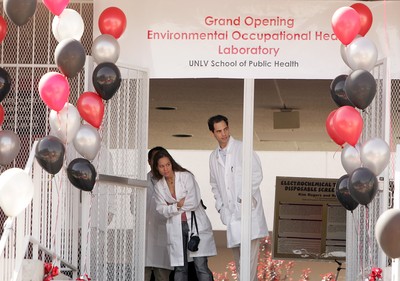New lab brings high hopes
After making a name for itself by alerting health officials to lead-tainted candy on local store shelves, UNLV's School of Public Health will expand its scope of testing for chemical poisoning with the help of a new $500,000 laboratory.
"We've got a lot of expectations," Dr. Shawn Gerstenberger, chairman of the school's department of environmental and occupational health, said during the opening of the lab Wednesday.
Now researchers in the Environmental and Occupational Health Laboratory can test the level of metals in almost anything, and they're setting their sights on several local environmental issues.
The lab includes several new pieces of equipment:
• A microwave digester powerful enough to turn rocks into a clear liquid through the use of acids, temperature and pressure.
• A cold vapor mercury analyzer used to monitor mercury levels in human blood, human hair and animal tissue.
• An ultraviolet-visible spectrophotometer that can monitor changes in water quality.
• A graphite furnace used to measure the amount and content of metals in various objects, including biological subjects such as humans and animals.
Mary Guinan, founding dean of the School of Public Health, said the environmental health department started off with no equipment when it was founded in 2004.
Faced with a shortage of funds, Guinan said, she persuaded the University of Nevada, Las Vegas to pay for a $27,000 hand-held lead analyzer. Until then, Nevada was the only state without a device to analyze lead levels, she said.
Gerstenberger said he wanted to analyze the lead levels in candy, a study that resulted in the Clark County Health District, now called the Southern Nevada Health District, banning several brands of Mexican candy from 1,600 local stores.
"I said, 'If we can do this, they'll invest in us,'" Guinan said.
That investment came with help from U.S. Sen. Harry Reid, D-Nev., who was able to procure a $500,000 appropriation from the U.S. Department of Energy for several devices that are able to expand UNLV's research.
"This lab is something that is long, long overdue," Reid said after a tour Wednesday.
Gerstenberger said he already has heard from researchers at the Environmental Protection Agency, on the UNLV campus, who also want to use the lab to perform tests.
UNLV President David Ashley said the lab was "one of the fundamental building blocks" to compete for research grants.
In addition to continuing to research the lead level in local candy, Gerstenberger said he plans to monitor fish in Lake Mead and Ash Meadows for chemical concentrations and help local agencies determine when to issue fish consumption advisories.
The lab also will be able to help determine the impact of quagga mussels, the invasive creatures discovered at Lake Mead in January.
And Gerstenberger said he wants to look at cultural items in the Hispanic community, such as pottery that uses a glaze called greta. Greta glazes have extraordinarily high levels of lead, he said.
UNLV graduate student Tracy Donnelly, who is scheduled to receive her master's degree in public health in May, said that despite the efforts to curb the availability of lead-tainted candy on local store shelves, the items are widely available.
"We're trying to say, 'Look, there's lead in this. It shouldn't be on store shelves,'" Donnelly said, as a machine next to her tested the amount of lead in a candy wrapper.
She said food shouldn't have more lead than 0.2 parts per million of lead. The candy wrapper she was testing had roughly 2 parts per million.
"Our Las Vegas kids are being exposed," she said.


















